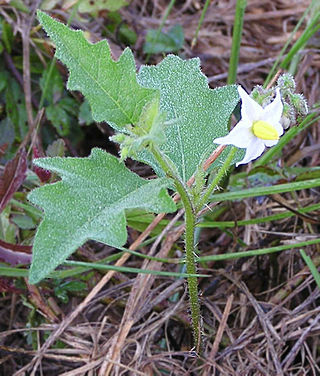
Solanum carolinense, the Carolina horsenettle, is not a true nettle, but a member of the Solanaceae, or nightshade family. It is a perennial herbaceous plant, native to the southeastern United States, though its range has expanded throughout much of temperate North America. The plant is an invasive in parts of Europe, Asia, Africa and Australia. The stem and undersides of larger leaf veins are covered with prickles.

Manduca quinquemaculata, the five-spotted hawkmoth, is a brown and gray hawk moth of the family Sphingidae. The caterpillar, often referred to as the tomato hornworm, can be a major pest in gardens; they get their name from a dark projection on their posterior end and their use of tomatoes as host plants. Tomato hornworms are closely related to the tobacco hornworm Manduca sexta. This confusion arises because caterpillars of both species have similar morphologies and feed on the foliage of various plants from the family Solanaceae, so either species can be found on tobacco or tomato leaves. Because of this, the plant on which the caterpillar is found does not indicate its species.

Manduca blackburni, the Hawaiian tomato hornworm, Hawaiian tobacco hornworm or Blackburn's sphinx moth, is a moth in the family Sphingidae.
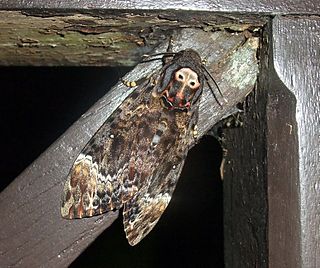
Acherontia lachesis, the greater death's head hawkmoth or bee robber, is a large sphingid moth found in India, Sri Lanka and much of the Oriental region. It is one of the three species of death's-head hawkmoth genus, Acherontia. The species was first described by Johan Christian Fabricius in 1798. It is nocturnal and very fond of honey; they can mimic the scent of honey bees so that they can enter a hive unharmed to get honey. Their tongue, which is stout and very strong, enables them to pierce the wax cells and suck the honey out. This species occurs throughout almost the entire Oriental region, from India, Pakistan and Nepal to the Philippines, and from southern Japan and the southern Russian Far East to Indonesia, where it attacks colonies of several different honey bee species. It has recently become established on the Hawaiian Islands.

Chrysodeixis eriosoma, the green garden looper, known in New Zealand as the Silver Y, is a moth of the family Noctuidae. Mostly cosmopolitan in distribution, it is a pest in Japan, China, India, Sri Lanka, the Malay Peninsula and Australasia. It is present in Hawaii and recorded as an incursion in mainland North America and Russia. It is morphologically identical to Chrysodeixis chalcites and the two may be sibling species.

Emmelina monodactyla is a moth of the family Pterophoridae found in Africa, Asia, Europe and North America. It was first described by Carl Linnaeus in 1758.

Anachloris subochraria is a species of moth of the family Geometridae. It is found in New Zealand and the southern half of Australia including Tasmania and from Queensland across to Western Australia. This moth is day flying and can be found in New Zealand on the wing between November and April.
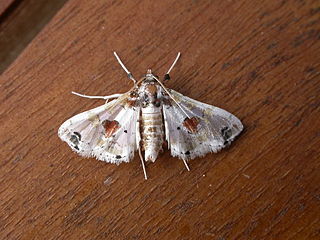
Leucinodes is a genus of moths of the family Crambidae. It was first described by Achille Guenée in 1854.

Scrobipalpa aptatella is a moth of the family Gelechiidae. It is found in China (Xinjiang), Australia, New Zealand, Samoa, India, Indonesia (Sumatra), Malaysia, Myanmar, Sri Lanka, Palestine and in Africa, where it has been recorded from the Democratic Republic of Congo, Kenya, Malawi, Namibia, South Africa, Tanzania and Zimbabwe.
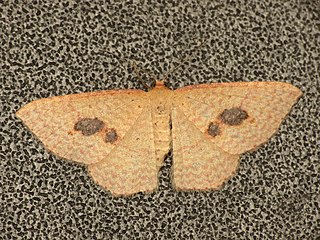
Epicyme is a monotypic moth genus in the family Geometridae described by Edward Meyrick in 1885. Its only species, Epicyme rubropunctaria, the red-spotted delicate, described by Edward Doubleday in 1843, is found in New Zealand, the Australian Capital Territory, Tasmania and Victoria.

Leucinodes orbonalis, the eggplant fruit and shoot borer or brinjal fruit and shoot borer, is a moth species in the genus Leucinodes described by Achille Guenée in 1854. Its native distribution is in the tropical and subtropical parts of Australia and Asia, where it is recorded from Pakistan, Nepal, India, including the Andaman Islands, Sri Lanka, Bangladesh, Myanmar, Laos, Cambodia, Vietnam, Thailand, China, Taiwan, Japan, Malaysia, Singapore, Brunei, the Philippines, and Indonesia (Java). It has also been intercepted from fruit imports in the U.S.A., the Netherlands, Denmark and Great Britain, where it was also reported from the wild. A taxonomic revision of the Leucinodes species of Sub-Saharan Africa concluded that L. orbonalis is currently not present in Africa, and that previous records of this species were misidentifications of previously undescribed species.

Leucinodes laisalis is a species of moth in the family Crambidae.
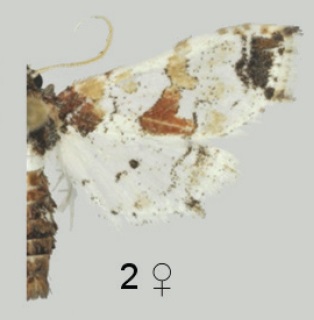
Leucinodes africensis is a species of moth in the family Crambidae. It is found in West Africa, Angola, the Democratic Republic of the Congo, Gabon and Tanzania. It has been intercepted with plant imports from Ghana and Zimbabwe to Great Britain and the Netherlands. The species was described by Richard Mally, Anastasia Korycinska, David J. L. Agassiz, Jayne Hall, Jennifer Hodgetts and Matthias Nuss in 2015.
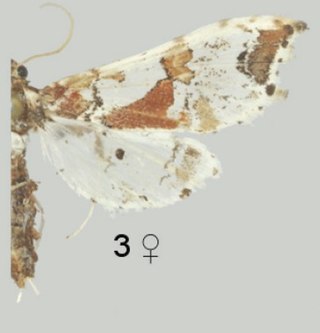
Leucinodes rimavallis is a species of moth in the family Crambidae. It is found in Burundi, eastern and southern Democratic Republic of the Congo, Kenya, Rwanda, South Africa and Uganda. The species was described by Richard Mally, Anastasia Korycinska, David J. L. Agassiz, Jayne Hall, Jennifer Hodgetts and Matthias Nuss in 2015.
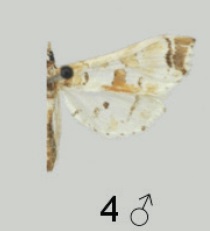
Leucinodes pseudorbonalis is a species of moth in the family Crambidae. It is found in Angola, Senegal and Uganda. The species was described by Richard Mally, Anastasia Korycinska, David J. L. Agassiz, Jayne Hall, Jennifer Hodgetts and Matthias Nuss in 2015.
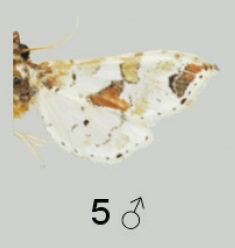
Leucinodes kenyensis is a species of moth in the family Crambidae. It is found in Kenya and possibly Zimbabwe. The species was described by Richard Mally, Anastasia Korycinska, David J. L. Agassiz, Jayne Hall, Jennifer Hodgetts and Matthias Nuss in 2015.

The Solanaceae, or the nightshades, are a family of flowering plants that ranges from annual and perennial herbs to vines, lianas, epiphytes, shrubs, and trees, and includes a number of agricultural crops, medicinal plants, spices, weeds, and ornamentals. Many members of the family contain potent alkaloids, and some are highly toxic, but many—including tomatoes, potatoes, eggplant, bell and chili peppers—are used as food. The family belongs to the order Solanales, in the asterid group and class Magnoliopsida (dicotyledons). The Solanaceae consists of about 98 genera and some 2,700 species, with a great diversity of habitats, morphology and ecology.
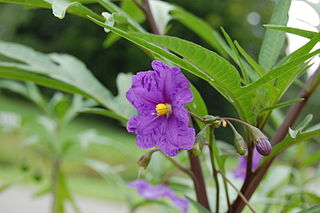
Solanum laciniatum a soft-wooded shrub native to the east coast of Australia, notably Victoria and Tasmania. It also occurs in Western Australia and New Zealand, where some authorities consider it to be introduced. It is similar to Solanum aviculare, with which it shares the common name kangaroo apple. The common name refers to the likeness of the leaf shape to a kangaroo paw print. This plant is currently being cultivated to produce corticosteroid drugs.

Lineodini is a tribe of the species-rich subfamily Spilomelinae in the snout moth family Crambidae.

Solanum esuriale is a species of perennial herbaceous plant native to Australia.





















